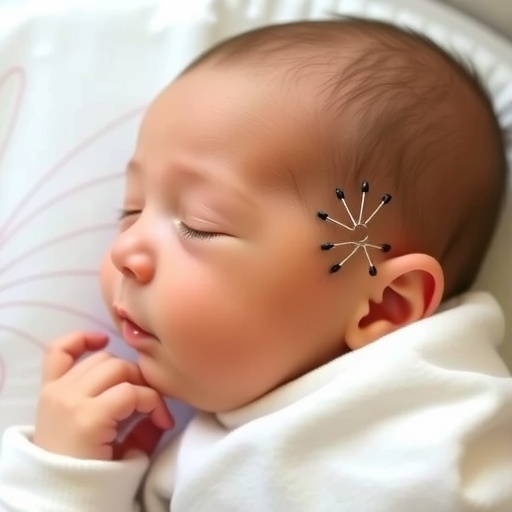In recent years, the integration of alternative therapeutic modalities into conventional medical practices has garnered significant attention. A compelling study led by Li et al. investigates the impact of magnetic auricular acupuncture on alleviating pain in newborns undergoing ophthalmic examinations. As infants are inherently vulnerable, especially during medical procedures, this research holds immense significance for pediatric care and pain management strategies.
The study, a multicenter, triple-blinded, randomized controlled trial, highlights the need for innovative solutions in managing pain during ophthalmic assessments for newborns. Standard procedures often result in distress for these young patients, which can compromise the accuracy of clinical evaluations. By focusing on a non-invasive approach such as auricular acupuncture, the researchers aim to contribute to more humane and effective pediatric healthcare practices.
Auricular acupuncture, a technique rooted in traditional Chinese medicine, involves the stimulation of specific points on the ear to promote healing and alleviate discomfort. The uniqueness of this study lies in its incorporation of a magnetic component, which is theorized to enhance the therapeutic effects of traditional acupuncture techniques. By utilizing magnets placed at specific auricular points, the researchers sought to investigate whether this approach could mitigate the pain experienced by newborns during ophthalmic examinations.
The methodology of the study is robust, featuring a multicenter design that increases the validity and reliability of its findings. By enrolling participants from various locations, the researchers ensure that their results are applicable to a broader population, enhancing the external validity of the study. The triple-blinded approach further strengthens the study’s design, as neither the participants, the healthcare providers, nor the investigators are aware of the treatment allocations, thereby minimizing bias.
Pain management in pediatric medicine is a critical area of focus. Infants, often unable to express their discomfort verbally, may experience significant stress during examinations. The implications of such distress extend beyond immediate discomfort, as stress in early life can have long-term repercussions on development and health outcomes. This study brings to the forefront the urgent need for effective pain management strategies that are both safe and non-invasive.
The findings of the study are expected to provide valuable insights into the efficacy of magnetic auricular acupuncture in this context. Preliminary hypotheses suggest that magnetic stimulation on auricular points may activate neural pathways associated with pain modulation, potentially leading to reduced pain perception during examinations. If proven effective, this technique could transform the standard of care for newborns undergoing ophthalmic assessments, offering a compassionate solution to an otherwise distressing experience.
Additionally, the implications for clinical practice are profound. Should the results indicate significant pain relief through this method, healthcare providers may begin to integrate magnetic auricular acupuncture as a standard adjunct to pediatric ophthalmic procedures. This shift could lead to more positive experiences for patients and families, ultimately enhancing compliance and improving overall health outcomes.
Moreover, this research contributes to a growing body of literature advocating for the incorporation of integrative health practices into mainstream medicine. As patients and healthcare professionals alike seek holistic approaches to medical care, studies such as this one serve as a critical bridge between traditional practices and contemporary medical science.
The meticulous nature of this research will provide clarity on the specific mechanisms by which magnetic auricular acupuncture operates. It is essential to understand whether the benefits arise solely from the magnetic stimulation or if the classic principles of acupuncture play a significant role as well. This understanding will guide future research directions and clinical applications.
In an era where patient-centered care is paramount, investigations into pain management for vulnerable populations, such as newborns, must continue to be prioritized. The objective of reducing procedural pain not only fosters better health care experiences but also aligns with ethical considerations regarding the treatment of infants and children.
As healthcare systems around the world grapple with the delicate balance of ensuring effective treatment while minimizing discomfort, studies like the one conducted by Li et al. offer hope for innovative solutions. The possible implementation of magnetic auricular acupuncture could symbolize a significant advancement in the paradigm of pediatric care, blending the wisdom of traditional practices with modern evidence-based medicine.
Attention to this research underscores the changing landscape of healthcare, where research findings have the potential to revolutionize existing protocols and improve patient outcomes. The study’s anticipated impact on clinical practice could resonate beyond ophthalmology, paving the way for broader applications of magnetic auricular acupuncture in other areas of pediatric medicine.
Ultimately, as this research unfolds, it has the potential to inspire further investigations into the intersection of alternative therapies and conventional medical practices. The quest for effective and compassionate care for our youngest patients continues, driven by innovative solutions and a commitment to excellence in healthcare provision.
By examining the effects of magnetic auricular acupuncture on the specific context of pain management in newborns, Li et al. not only further scientific understanding but also strive to make meaningful contributions to the field of pediatric medicine. The findings could have far-reaching consequences, influencing how healthcare professionals approach pain management for infants in clinical settings and potentially reshaping treatment protocols for future generations.
As we await the publication of comprehensive results from this multicenter study, the anticipation builds not only among the medical community but also among families seeking safer and more effective pathways for their children’s healthcare journeys. This innovative approach to addressing procedural pain in newborns exemplifies the spirit of exploration and discovery that drives progress in the ever-evolving field of medicine.
Subject of Research: Magnetic auricular acupuncture and its effects on pain management during ophthalmic examination of newborns.
Article Title: Effect of magnetic auricular acupuncture on pain during ophthalmic examination of the newborn: a multicenter, triple-blinded, randomized controlled study.
Article References:
Li, L., Tuerxun, R., Su, Y. et al. Effect of magnetic auricular acupuncture on pain during ophthalmic examination of the newborn: a multicenter, triple-blinded, randomized controlled study.
BMC Pediatr 25, 760 (2025). https://doi.org/10.1186/s12887-025-06126-1
Image Credits: AI Generated
DOI: 10.1186/s12887-025-06126-1
Keywords: Magnetic auricular acupuncture, pain management, newborns, ophthalmic examination, pediatric care.
Tags: alternative therapies in conventional medicineauricular acupuncture benefits for infantsclinical trials on newborn pain reductioneffectiveness of acupuncture in pediatric careenhancing pediatric patient experiencesimproving outcomes in ophthalmic examinations for babiesinnovative approaches to healthcare for vulnerable populationsmagnetic auricular acupuncture for newbornsminimizing distress during medical procedures for newbornsnon-invasive pain relief techniques for infantspain management in pediatric ophthalmologytraditional Chinese medicine applications in modern healthcare





